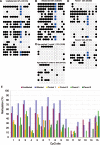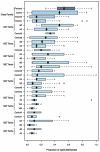Increased DNA methylation at the AXIN1 gene in a monozygotic twin from a pair discordant for a caudal duplication anomaly - PubMed (original) (raw)
Increased DNA methylation at the AXIN1 gene in a monozygotic twin from a pair discordant for a caudal duplication anomaly
N A Oates et al. Am J Hum Genet. 2006 Jul.
Abstract
The AXIN1 gene has been implicated in caudal duplication anomalies. Its coding region was sequenced in both members of a monozygotic (MZ) twin pair discordant for a caudal duplication anomaly, but no mutation was found. Using bisulfite sequencing, we examined methylation at the promoter region of the AXIN1 gene in these twins and in twin and age-matched singleton controls. Methylation of the promoter region in peripheral blood mononucleated cells was variable among individuals, including MZ pairs. In the MZ pair discordant for the caudal duplication, this region of the affected twin was significantly more methylated than that of the unaffected twin (P < .0001), which was significantly more methylated than those of the controls (P = .02). We have confirmed that this CpG island does function as a promoter in vitro and that its activity is inversely proportional to the extent of methylation. This finding raises the possibility that hypermethylation of the AXIN1 promoter, by mechanisms as yet undetermined, is associated with the malformation. This case may be paradigmatic for some cases of MZ discordance.
Figures
Figure 1.
AXIN1 CpG island methylation in the MZ twin pair (A, unaffected; B, affected) discordant for caudal duplication anomaly, their parents (D), and age- and sex-matched controls (C). An open circle represents an unmethylated CpG, a filled circle represents a methylated CpG, and each row of circles represents the methylation state of all 15 CpGs on a single allele. The square represents a SNP (G→T [dbSNP _rs12928797_]) commonly found in the samples analyzed. Overall percentage of methylation was calculated by determining the proportion of methylated CpGs relative to all CpGs. A detailed analysis of the methylation state at each CpG site is also shown (E).
Figure 2.
Box-and-whisker plot of proportion-methylated CpG sites in the AXIN1 promoter per clone for each individual. Individuals are ordered by familial mean methylation level, with the index family at the top. Length of bar is interquartile range, and bar width is proportional to the number of clones analyzed for that individual. Solid diamonds are medians, and dashed lines extend to the observations 1.5× the interquartile range from the median, with open circles representing more-extreme values.
Figure 3.
The degree of methylation of the AXIN1 promoter correlates with its activity in HEK 293 cells. A fragment of the AXIN1 locus, corresponding to nucleotides −416 to +114 relative to the start point of transcription (as determined by Evidence Viewer), was amplified by PCR from human genomic DNA (Promega). For a more detailed description of the methods used, see the main text. A similar trend was also seen in HeLa cells (data not shown). Each data point is the average of six replicates. Error bars represent two SDs.
Figure 4.
Quantification of X-chromosome inactivation in PBMCs by PCR amplification of the polymorphic human androgen-receptor (HUMARA) locus after digestion with _Rsa_I or _Rsa_I and _Hpa_II. Although the pair both display some skewing towards the larger allele, the pattern is highly consistent in both twins.
Similar articles
- Hypomethylation within gene promoter regions and type 1 diabetes in discordant monozygotic twins.
Elboudwarej E, Cole M, Briggs FB, Fouts A, Fain PR, Quach H, Quach D, Sinclair E, Criswell LA, Lane JA, Steck AK, Barcellos LF, Noble JA. Elboudwarej E, et al. J Autoimmun. 2016 Apr;68:23-9. doi: 10.1016/j.jaut.2015.12.003. Epub 2016 Jan 9. J Autoimmun. 2016. PMID: 26782299 Free PMC article. - Evidence for monozygotic twin (MZ) discordance in methylation level at two CpG sites in the promoter region of the catechol-O-methyltransferase (COMT) gene.
Mill J, Dempster E, Caspi A, Williams B, Moffitt T, Craig I. Mill J, et al. Am J Med Genet B Neuropsychiatr Genet. 2006 Jun 5;141B(4):421-5. doi: 10.1002/ajmg.b.30316. Am J Med Genet B Neuropsychiatr Genet. 2006. PMID: 16583437 - Integration of DNA sequence and DNA methylation changes in monozygotic twin pairs discordant for schizophrenia.
Castellani CA, Melka MG, Gui JL, O'Reilly RL, Singh SM. Castellani CA, et al. Schizophr Res. 2015 Dec;169(1-3):433-440. doi: 10.1016/j.schres.2015.09.021. Epub 2015 Oct 4. Schizophr Res. 2015. PMID: 26441003 - DNA methylation differences in monozygotic twin pairs discordant for schizophrenia identifies psychosis related genes and networks.
Castellani CA, Laufer BI, Melka MG, Diehl EJ, O'Reilly RL, Singh SM. Castellani CA, et al. BMC Med Genomics. 2015 May 6;8:17. doi: 10.1186/s12920-015-0093-1. BMC Med Genomics. 2015. PMID: 25943100 Free PMC article. - Intra-Monozygotic Twin Pair Discordance and Longitudinal Variation of Whole-Genome Scale DNA Methylation in Adults.
Zhang N, Zhao S, Zhang SH, Chen J, Lu D, Shen M, Li C. Zhang N, et al. PLoS One. 2015 Aug 6;10(8):e0135022. doi: 10.1371/journal.pone.0135022. eCollection 2015. PLoS One. 2015. PMID: 26248206 Free PMC article.
Cited by
- Understanding transgenerational epigenetic inheritance via the gametes in mammals.
Daxinger L, Whitelaw E. Daxinger L, et al. Nat Rev Genet. 2012 Jan 31;13(3):153-62. doi: 10.1038/nrg3188. Nat Rev Genet. 2012. PMID: 22290458 Review. - Ageing and cancer as diseases of epigenesis.
Gilbert SF. Gilbert SF. J Biosci. 2009 Oct;34(4):601-4. doi: 10.1007/s12038-009-0077-4. J Biosci. 2009. PMID: 19920344 Review. - Wnt signaling in cervical cancer?
Yang M, Wang M, Li X, Xie Y, Xia X, Tian J, Zhang K, Tang A. Yang M, et al. J Cancer. 2018 Mar 20;9(7):1277-1286. doi: 10.7150/jca.22005. eCollection 2018. J Cancer. 2018. PMID: 29675109 Free PMC article. Review. - Monozygotic twins: genes are not the destiny?
Chatterjee A, Morison IM. Chatterjee A, et al. Bioinformation. 2011;7(7):369-70. doi: 10.6026/97320630007369. Epub 2011 Dec 10. Bioinformation. 2011. PMID: 22355239 Free PMC article. - Two cases of atypical twinning: Phenotypically discordant monozygotic and conjoined twins.
Barnes-Davis ME, Cortezzo DE. Barnes-Davis ME, et al. Clin Case Rep. 2019 Mar 29;7(5):920-925. doi: 10.1002/ccr3.2113. eCollection 2019 May. Clin Case Rep. 2019. PMID: 31110715 Free PMC article.
References
Web Resources
- dbSNP, http://www.ncbi.nlm.nih.gov/SNP/ (for rs12928797)
- Ensembl Build 35, http://www.ensembl.org (accession numbers 341973-343464)
- Evidence Viewer, http://www.ncbi.nlm.nih.gov/
- Online Mendelian Inheritance in Man (OMIM), http://www.ncbi.nlm.nih.gov/Omim/ (for caudal duplication anomaly, AXIN1, HBA1, and HBA2)
References
- Torrey EF, Bowler AE, Taylor EH, Gottesman II (1994) Schizophrenia and manic-depressive disorder: the biological roots of mental illness as revealed by the landmark study of identical twins. Basic Books, New York
- Floderus B, Cederlof R, Friberg L (1988) Smoking and mortality: a 21-year follow-up based on the Swedish Twin Registry. Int J Epidemiol 17:332–340 - PubMed
- Petronis A, Gottesman II, Kan P, Kennedy JL, Basile VS, Paterson AD, Popendikyte V (2003) Monozygotic twins exhibit numerous epigenetic differences: clues to twin discordance? Schizophr Bull 29:169–178 - PubMed
Publication types
MeSH terms
Substances
LinkOut - more resources
Full Text Sources
Other Literature Sources
Molecular Biology Databases



